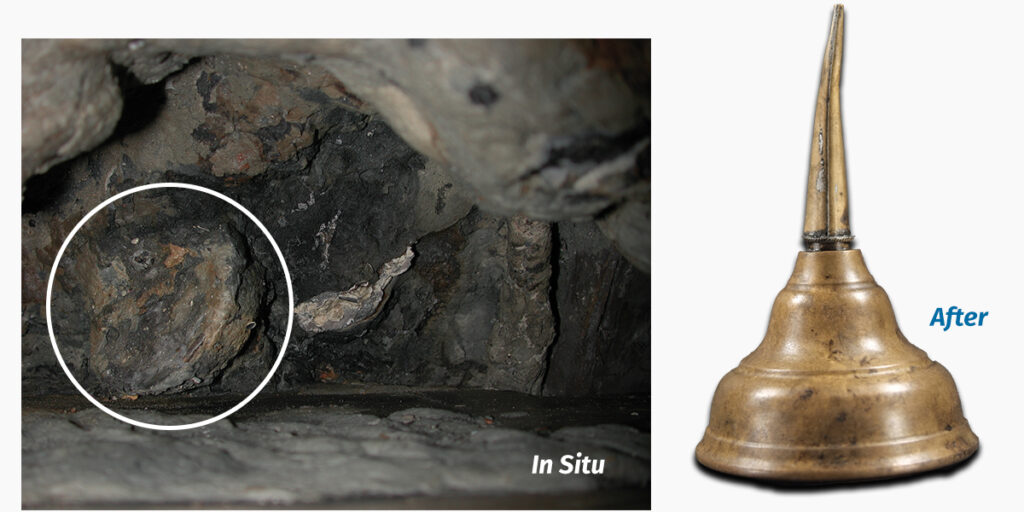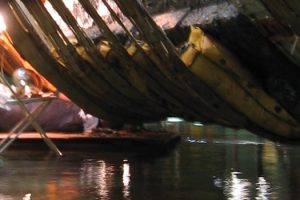Tools Found Onboard Hunley Offered Crew a Potential Lifeline
Many people know the Hunley’s significant place in naval history as the world’s first successful combat submarine. The daring story of her against-all-odds attack has fascinated children and adults for over a century. Often lost in the many intriguing tales surrounding Hunley and her history is the painstaking detail that went into her construction, maintenance, and operation. With approximately 5,000 rivets, joints, and moving parts, the Hunley no doubt required a great deal of planning and care to keep her seaworthy and attack ready. As one of the first submarines, she was also always a “work in progress.” The designers and crews made constant modifications and adjustments to improve upon their unprecedented attempts to take the battle at sea beneath the water’s surface. That’s why it wasn’t surprising when Archaeologists uncovered during excavation an array of tools scattered beneath and around the forward section of the crew compartment.
“The inside of the Hunley is so small that every item brought onboard by her crew had to be thought out and have a purpose. Given the many emergencies that could occur during operation of the vessel, the tools were likely considered a necessity.
They could prove to be a lifeline for the crew in the event of a catastrophic malfunction or damage that may occur during their highly risky mission,” said Michael Scafuri, Clemson University Archaeologist.
Many of the tools, including a hammer, bolts, and wrench, were discovered beneath the captain’s bench. Also within reach for the Captain at his station was a glass bottle and oil can. The collection of tools has now been fully conserved and will go on display as part of the Tools and Tides exhibit in early 2025 for visitors to see at the Hunley lab in Charleson, SC.
“These tools are daily artifacts that will help add texture and context to the development of the Hunley and will make a great addition to our current displays,” said Kellen Butler, Executive Director of Friends of the Hunley.
Hammer
This iron ball-peen hammer was found directly beneath the forward pump outflow pipe under Captain Dixon’s seat. The hammer is considered a composite object meaning it is made of different materials requiring different conservation methods. For example, the treatment used for the metal can be detrimental for the wood. The Clemson Conservation team removed the iron head of the hammer and placed it in sodium hydroxide. The wooden handle was immersed in polyethylene glycol. The sections were then rinsed and freeze dried.

T-shaped Tool
This iron t-shaped tool with a square end was found near Captain Dixon’s station. Its location between the pump mechanism and the frame ring suggests it was used to adjust or remove portions of the forward ballast pump.

Oil Can
A brass oil can, still containing some 19th century oil, was found on the wooden shelf in the forward portion of the captain’s station. The location of the oil can on the shelf suggests that Captain Dixon wanted it to be readily available to lubricate the many moving components in the submarine.

Wrench
This large adjustable monkey wrench with a curved handle was found under Captain Dixon’s seat and would have had many functions on the submarine. To preserve it, the wrench underwent desalination in sodium hydroxide and then was rinsed in deionized water and placed in the lab oven to quickly dry. The objects were then cleaned with air abrasion and a special coating was applied to protect the metal.

Bolts
These bolts with an attached nut were found directly beneath the forward pump outflow pipe under Captain Dixon’s seat. The scientific team is still researching their function, but they could have been integral components in the pump system’s operation.
The bolts were treated using a sub-critical chamber, a cutting-edge conservation technique developed by the Hunley scientific team. After treatment in the chamber was completed, the artifacts were then rinsed, dried, and coated.




